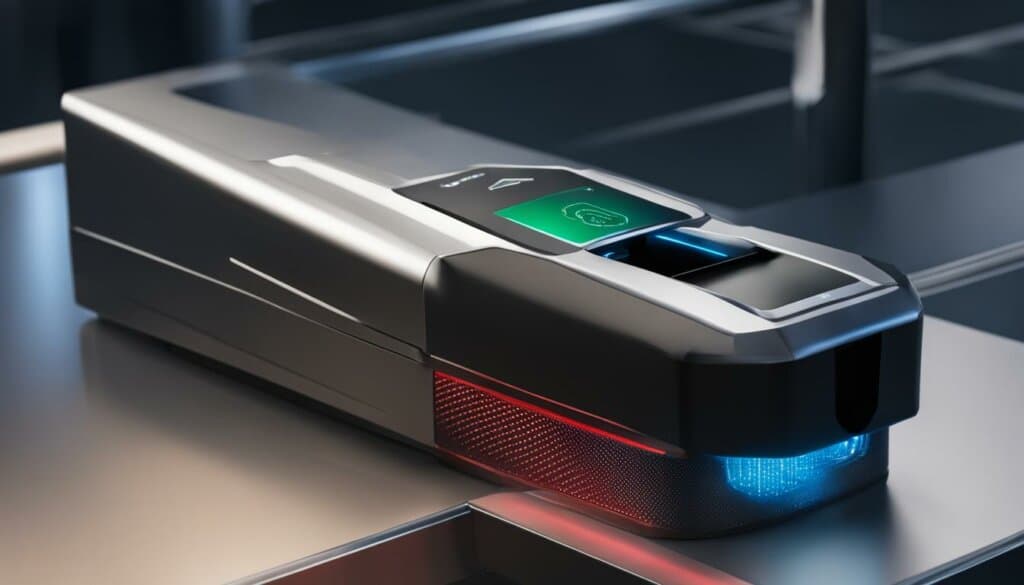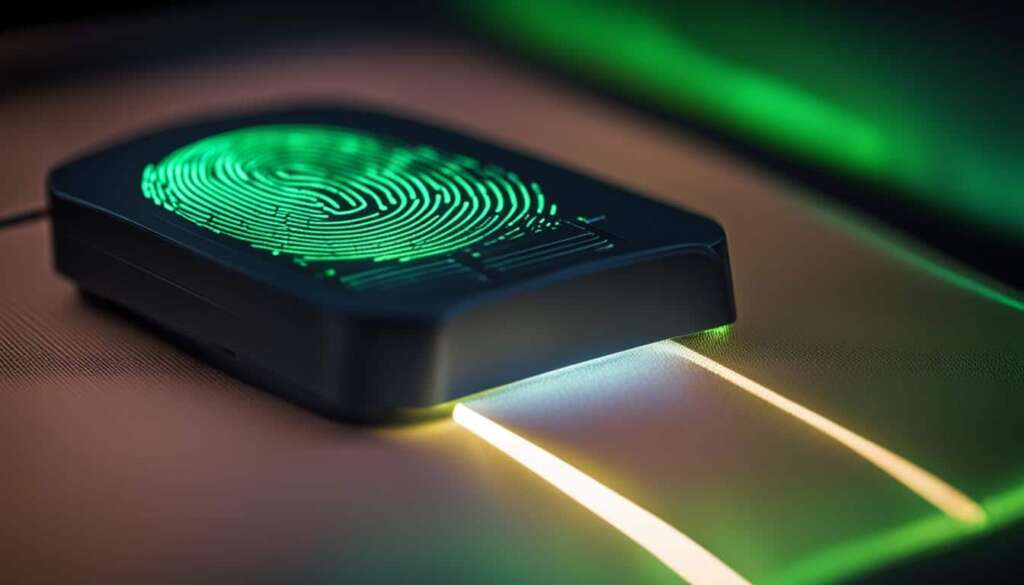Table of Contents
Biometric security has become a crucial layer in personal and enterprise security systems. It utilizes unique biological or behavioral identifiers to authenticate individuals. This article provides an overview of biometric security, including its definition, types, benefits, and applications.
Biometric security plays a vital role in ensuring the safety and integrity of digital systems. With the rise of biometric technology, including fingerprint authentication, facial recognition, and iris recognition, biometric systems have become more advanced and widely used.
Biometric identification and access control offer enhanced security compared to traditional authentication methods like passwords. They provide a higher level of accuracy and reliability, as biometric data is unique to each individual.
Throughout this article, we will explore the different types of biometric security, how it works, real-world examples, its applications in various industries, and the importance of protecting biometric data. By the end, you will have a comprehensive understanding of the capabilities and potential of biometric security systems.
What is Biometrics?
Biometrics refers to the use of biological measurements or physical characteristics to identify individuals. It utilizes unique identifiers such as fingerprint mapping, facial recognition, and iris scanning to provide a more secure alternative to traditional passwords and access control methods. Unlike passwords, which can easily be forgotten, stolen, or shared, biometrics are inherent to each individual, making them a reliable and convenient form of authentication.
Biometric security systems capture and analyze these physical traits to establish an individual’s identity. For example, fingerprint recognition technology uses complex algorithms to map the unique patterns on a person’s fingertip. When a user attempts to access a device or system, their fingerprint is scanned and compared to the stored database to grant or deny access.
“Biometrics offers a more secure and convenient alternative to traditional passwords and access control methods.”
Biometric technology has rapidly evolved over the years and is now widely used in various industries and applications. It provides a higher level of security by relying on personal traits that are difficult to replicate, ensuring that only authorized individuals can gain access to protected information or areas.
Table: Types of Biometrics and Their Applications
| Type of Biometrics | Applications |
|---|---|
| Fingerprint | Access control, mobile devices, financial transactions |
| Facial Recognition | Surveillance, identity verification, law enforcement |
| Iris Scanning | Border control, healthcare, high-security environments |
| Voice Recognition | Phone banking, call centers, voice assistants |
| Hand Geometry | Physical access control, time and attendance tracking |
These are just a few examples of the many types of biometrics used in today’s security systems. As technology continues to advance, biometric authentication methods are becoming more sophisticated, accurate, and widely adopted. They play a crucial role in safeguarding sensitive data and ensuring the integrity of both personal and enterprise security systems.
Types of Biometric Security
Biometric security can be categorized into three types: biological biometrics, morphological biometrics, and behavioral biometrics.
Biological Biometrics
Biological biometrics involve the use of genetic or molecular traits to authenticate individuals. These traits are unique to each person and can include DNA, blood type, or other biological markers. Biological biometrics provide a high level of accuracy and are often used in forensic investigations or medical applications.
Morphological Biometrics
Morphological biometrics rely on physical characteristics to identify individuals. This includes features such as fingerprints, eye shapes, or facial features. Morphological biometrics are widely used in access control systems, where an individual’s physical traits are compared to a stored database to grant or deny entry.
Behavioral Biometrics
Behavioral biometrics are based on unique patterns of behavior exhibited by individuals. This can include the way a person walks, types on a keyboard, or even their voice. Behavioral biometrics are often used in continuous authentication systems, where an individual’s behavior is constantly monitored to detect any suspicious activity.
| Biometric Type | Examples | Applications |
|---|---|---|
| Biological Biometrics | DNA, blood type | Forensic investigations, medical applications |
| Morphological Biometrics | Fingerprints, eye shapes, facial features | Access control systems, border control |
| Behavioral Biometrics | Walking pattern, typing style, voice | Continuous authentication, fraud detection |
Each type of biometric security has its own advantages and applications. Biological biometrics offer a high level of accuracy and are useful in forensic investigations or medical settings. Morphological biometrics provide a convenient and widely-used method of access control. Behavioral biometrics offer continuous authentication to detect suspicious activity. By combining these different types of biometrics, organizations can create robust and secure authentication systems.
How Biometric Security Works
Biometric security is a highly advanced technology that utilizes unique biological or behavioral identifiers to authenticate individuals. The process involves capturing an individual’s biometric data, which is then stored and compared to future authentication attempts. This data is captured using biometric scanners such as fingerprint or facial recognition systems. These scanners analyze and map the unique characteristics of an individual’s biometric data, creating a digital representation that is stored securely.
When a user attempts to access a device or system protected by biometric security, their biometric data is compared against the stored database. If the data matches, access is granted. If there is no match, access is denied. This seamless and efficient process provides a convenient way for individuals to authenticate themselves without the need for traditional passwords or access cards.
One of the key advantages of biometric security is its high level of security. Biometric data, such as fingerprints or facial features, are unique to each individual and cannot be easily replicated or stolen. This makes it extremely difficult for unauthorized individuals to gain access to protected systems or devices. Additionally, biometric authentication eliminates the risk of password theft or hacking, as no passwords are required.

Biometric Scanners
Biometric scanners are essential components of biometric security systems. These scanners are responsible for capturing an individual’s biometric data and converting it into a digital format for comparison. There are various types of biometric scanners, each designed to capture a specific type of biometric data. For example, fingerprint scanners use sensors to capture the unique patterns and ridges present on a person’s fingertips. Facial recognition scanners analyze facial features such as distance between the eyes, nose, and mouth, to create a unique facial template. These scanners utilize advanced algorithms and mathematical modeling to ensure accurate and reliable identification.
Biometric identification and authentication offer a secure and efficient method of protecting personal and enterprise data. With the continuous advancements in biometric technology and the increasing availability of biometric systems, it is likely that biometric security will become even more prevalent in the future.
| Advantages of Biometric Security | Disadvantages of Biometric Security |
|---|---|
|
|
Examples of Biometric Security
Biometric security systems have revolutionized authentication and access control in various industries. These systems utilize advanced technologies to accurately identify individuals based on unique biological or behavioral characteristics. Here are some examples of biometric security applications:
Fingerprint Scanning:
Fingerprint scanning is one of the most common and widely adopted biometric technologies. It analyzes the unique patterns and ridges on an individual’s fingers to authenticate their identity. This method is used in smartphones, laptops, and even in high-security areas such as government facilities or data centers. Fingerprint scanners provide a convenient and highly secure way to grant access to authorized personnel.
Facial Recognition:
Facial recognition technology is rapidly gaining popularity in various sectors, including law enforcement, airport security, and border control. It analyzes the unique features of an individual’s face, such as the shape of their eyes, nose, and mouth, to verify their identity. Facial recognition allows for fast and contactless authentication, making it a valuable tool in enhancing security and efficiency.
Iris Recognition:
Iris recognition is a highly accurate and secure biometric technology that utilizes the distinct patterns in an individual’s iris to verify their identity. The iris, which is the colored part of the eye, contains intricate and unique patterns that are almost impossible to replicate. Iris recognition systems are commonly used in high-security environments like banks, government agencies, and research facilities.
Voice Recognition:
Voice recognition technology analyzes an individual’s unique voice patterns, such as pitch, tone, and pronunciation, to authenticate their identity. This technology is commonly used in call centers for customer authentication and in voice-controlled systems like virtual assistants. Voice recognition provides a convenient and efficient way to verify an individual’s identity without the need for physical interaction.
Heart-Rate Sensors:
Heart-rate sensors are a relatively new addition to the biometric security landscape. These sensors measure an individual’s heart rate and use it as a unique identifier. This technology is particularly useful in healthcare settings, where it can ensure accurate patient identification and prevent unauthorized access to medical records. Heart-rate sensors can also be integrated into wearable devices for personal authentication purposes.
| Biometric Security Method | Application |
|---|---|
| Fingerprint Scanning | Access control for smartphones, laptops, and high-security areas |
| Facial Recognition | Law enforcement, airport security, and border control |
| Iris Recognition | Banks, government agencies, and research facilities |
| Voice Recognition | Call centers, voice-controlled systems |
| Heart-Rate Sensors | Healthcare settings, wearable devices |
Applications of Biometric Security
Biometric security plays a crucial role in various sectors, including law enforcement, military, border control, healthcare, and civil identity systems. The unique capabilities of biometric technology make it an invaluable tool for ensuring safety, enhancing security measures, and streamlining identification processes.
In the field of law enforcement, biometric security enables accurate and efficient criminal identification. Law enforcement agencies can use biometric data, such as fingerprints or facial recognition, to match individuals with records in their databases. This aids in investigations, apprehensions, and the overall maintenance of public safety.
The military also benefits from biometric security for defense purposes. Biometric authentication systems can be used to grant access to secure areas, restrict unauthorized entry, and ensure that only authorized personnel have access to sensitive information or equipment. By leveraging biometric technology, military organizations can enhance their security protocols and protect national interests.
Biometric security is also invaluable in border control, where it aids in travel and migration management. Biometric identification methods like iris recognition or fingerprint scanning can expedite the immigration process, making it efficient and secure. By implementing biometric solutions, border control agencies can strengthen security measures and effectively manage the inflow and outflow of individuals.
Biometric security is not limited to law enforcement or defense applications, as it also finds utility in the healthcare industry. Patient identification is a critical aspect of healthcare operations, and biometric technology can ensure accurate identification and prevent medical errors. When integrated into healthcare systems, biometrics can streamline patient management, protect sensitive medical information, and enhance overall healthcare quality.
Civil identity systems, such as population registration and voter registration, can also benefit from biometric security. By utilizing biometric data, governments can establish accurate and reliable identification systems. This improves the efficiency of public services, ensures fair elections, and helps maintain civil order.
In conclusion, biometric security has diverse applications across various sectors. Its implementation in law enforcement, military, border control, healthcare, and civil identity systems has proven to be effective in enhancing security, streamlining processes, and ensuring accurate identification. As technology continues to advance, the potential for further development and integration of biometric security systems is immense.
Safety and Protection of Biometric Data
Protecting biometric data is of utmost importance to ensure the security and privacy of individuals. As biometric security systems rely on unique biological or behavioral identifiers, any compromise of this data could have serious consequences. Therefore, it is crucial to implement robust measures to safeguard biometric data from unauthorized access or misuse.
To enhance biometric data security, encryption should be used when storing and transmitting data. Encryption converts the data into a coded form, making it difficult for potential attackers to decipher. Additionally, secure storage methods should be employed, whether the data is stored on the device itself or in a remote server. This can include access controls, firewalls, and intrusion detection systems.
Companies and organizations should also consider implementing multi-factor authentication alongside biometric security. This means requiring users to provide additional forms of verification, such as a password or a physical token, in addition to their biometric data. This adds an extra layer of protection, making it more difficult for unauthorized individuals to gain access.
| Measures to Protect Biometric Data |
|---|
| Use strong encryption algorithms to secure biometric data during storage and transmission. |
| Implement secure storage methods, including access controls, firewalls, and intrusion detection systems. |
| Require multi-factor authentication to ensure additional layers of verification. |
In addition to technical measures, organizations should establish comprehensive policies and procedures for the handling and protection of biometric data. This includes defining clear roles and responsibilities, conducting regular security awareness training for employees, and regularly reviewing and updating security protocols.
By implementing these safety measures and best practices, organizations can ensure the protection of biometric data and maintain the trust of individuals who rely on biometric security systems.

Advantages and Disadvantages of Biometric Security Systems
Biometric security systems offer numerous advantages that make them an appealing choice for personal and enterprise security. One of the key advantages is convenience. With biometric authentication, individuals no longer need to remember complex passwords or carry access cards. They can simply use their unique biometric traits, such as fingerprints or facial features, to gain access to their devices, accounts, or secure areas.
Another advantage of biometric security is the difficulty to steal or impersonate. Unlike passwords or access cards, which can be easily forgotten, lost, or stolen, biometric traits are inherently tied to individuals and cannot be easily duplicated. This makes it significantly more challenging for malicious actors to gain unauthorized access.
Furthermore, biometric security systems have the potential for future development and improvement. As technology advances, new biometric modalities and techniques are continuously being developed, further enhancing the accuracy and reliability of biometric authentication. This means that biometric security systems can evolve and adapt to changing security needs, providing stronger protection against emerging threats.
“Biometric security offers convenience, difficulty to steal or impersonate, and potential for future development.”
However, like any security system, biometric security also has its disadvantages. One major concern is the risk of biometric scanners being tricked. While modern biometric systems employ various anti-spoofing measures to detect and prevent such attacks, there are still methods, such as using high-resolution photographs or 3D face masks, that can potentially fool the system.
Additionally, there are privacy and ethical considerations surrounding the use of biometric data. Collecting and storing biometric information raises concerns about the potential misuse or unauthorized access to sensitive personal data. It is crucial for organizations implementing biometric security systems to establish robust data protection measures and ensure compliance with privacy regulations to mitigate these risks.
Overall, biometric security systems offer distinct advantages in terms of convenience, security, and future potential. However, it is essential to address the challenges and concerns associated with biometric authentication, such as spoofing and privacy issues, to ensure the responsible and effective implementation of these systems.
Conclusion
Biometric security is revolutionizing the field of cybersecurity, offering advanced safety measures and next-generation user verification methods. With the rise of biometric technology and systems, traditional passwords and access control methods are being replaced by unique biological or behavioral identifiers, such as fingerprint authentication and facial recognition.
One of the key advantages of biometric security is its enhanced level of security. Unlike passwords that can be easily hacked or stolen, biometric data is unique to each individual, making it difficult to impersonate or replicate. Biometric systems also provide convenience, as users no longer need to remember complex passwords, resulting in a smoother authentication process.
While biometric security systems have their advantages, there are also some concerns that need to be addressed. There is a risk of biometric scanners being tricked, which calls for continuous improvement in the technology to ensure foolproof identification. Additionally, the protection of biometric data is of utmost importance, as any breach can lead to severe privacy issues.
Despite these challenges, the potential for biometric security in shaping the future of cybersecurity is immense. It has already found applications in various sectors, including law enforcement, military, healthcare, and civil identity systems. As biometric technology continues to advance, we can expect to see further developments and innovations in this field, making our personal and enterprise security systems stronger than ever.
FAQ
What is biometric security?
Biometric security refers to the use of unique biological or behavioral identifiers, such as fingerprint mapping, facial recognition, or iris scanning, to authenticate individuals and provide an additional layer of security.
What are the types of biometric security?
Biometric security can be categorized into three types: biological biometrics, morphological biometrics, and behavioral biometrics. Biological biometrics use genetic or molecular traits, morphological biometrics involve physical characteristics like fingerprints and eye shapes, and behavioral biometrics are based on unique patterns of behavior like walking or typing.
How does biometric security work?
Biometric security works by capturing an individual’s biometric data, such as fingerprints or facial features, which is then stored and compared to future authentication attempts. Biometric scanners, like fingerprint or facial recognition systems, capture the biometric data and match it against the stored database to grant or deny access.
What are some examples of biometric security?
Examples of biometric security include voice recognition for secure authentication, fingerprint scanning for access control, facial recognition in e-passports, iris recognition in border control, and heart-rate sensors for identity verification.
What are the applications of biometric security?
Biometric security is used in various sectors, including law enforcement for criminal identification, military for defense purposes, border control for travel and migration management, healthcare for patient identification, and civil identity systems for population registration and voter registration.
How can biometric data be protected?
To protect biometric data, it is important to use encryption and secure storage methods, whether it is stored on the device itself or in a remote server. Additional security measures, such as multi-factor authentication and age/gender/height verification, can also be implemented to enhance the protection of biometric data.
Source Links
- https://www.kaspersky.com/resource-center/definitions/biometrics
- https://www.thalesgroup.com/en/markets/digital-identity-and-security/government/inspired/biometrics







